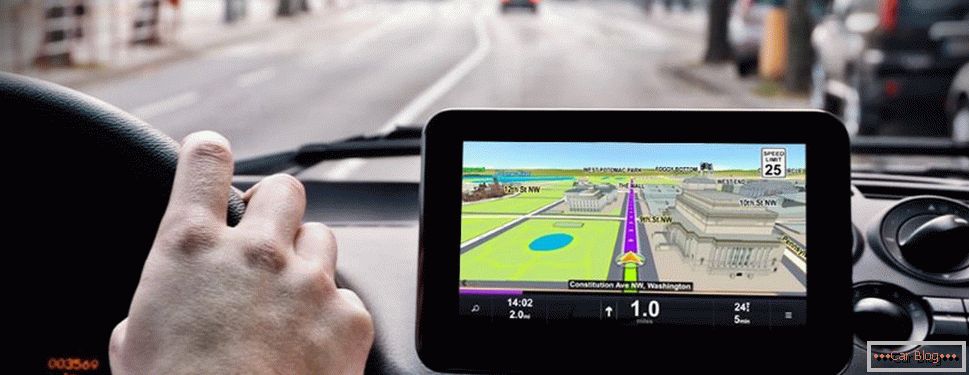A large number of cars uses lead serviced batteries in their work. For their full-fledged work, it is necessary to control not only the battery charge level, but also the quality of the electrolyte, the condition of the plates, the level of the liquid in the system.
The convenience of the design provides flexibility in the operation of the electrical device, so the replacement of the electrolyte in the battery by the driver can be carried out depending on the state of the liquid. For diagnosis, it is enough to conduct a visual inspection.
Content
- 1 Required materials and equipment
- 2 Preparatory operations
- 3 Replacement work
- 4 Final stage
- 5 Safe operation with electrolyte
Required materials and equipment
Using the procedure for replacing electrolyte car owner gets a chance to extend the life of a car battery. For the work will need the following components:
- tank with distillate;
- narrow-neck funnel;
- bottle with electrolyte of the required density;
- hydrometer for density measurement;
- small amount of baking soda;
- battery charger;
- personal protective equipment (glasses, gloves, apron, etc.);
- a small amount of clean rags.
Electrolyte and distilled water tanks are offered in specialized automotive stores. Water, in order to change the electrolyte in the battery, is prepared in a volume sufficient not only to dilute the liquid, but it will also need some amount to wash the cavities of the battery.
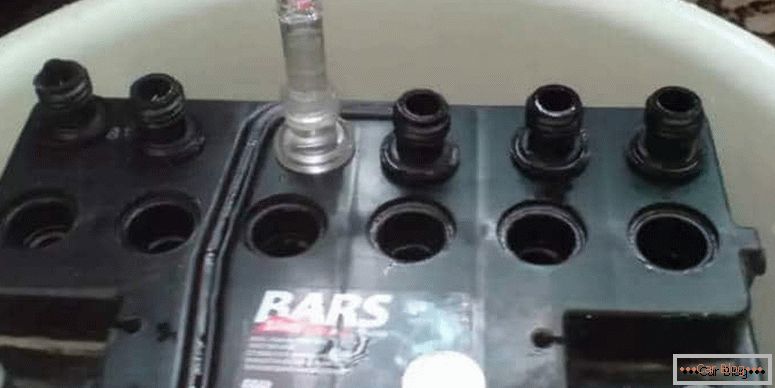
The funnel is preferable to be made of glass, since not all plastic or metal can withstand contact with acid, and the ceramic will have too small a diameter. It is also advisable to select acid-resistant and thick-walled containers for draining the acid.
Preparatory operations
Before you replace the electrolyte in the car battery, you need to fold the contact wires and remove the battery from the engine compartment. Next, remove all dirt from the outer surface with a dry cloth. After that you can wipe the battery with a rag soaked in a weak soda solution. The liquid is prepared at the rate of 30-50 g per liter of water. We unscrew the plugs to conduct a visual diagnosis of the electrolyte level in the tanks.
See also: Why the battery boils on the car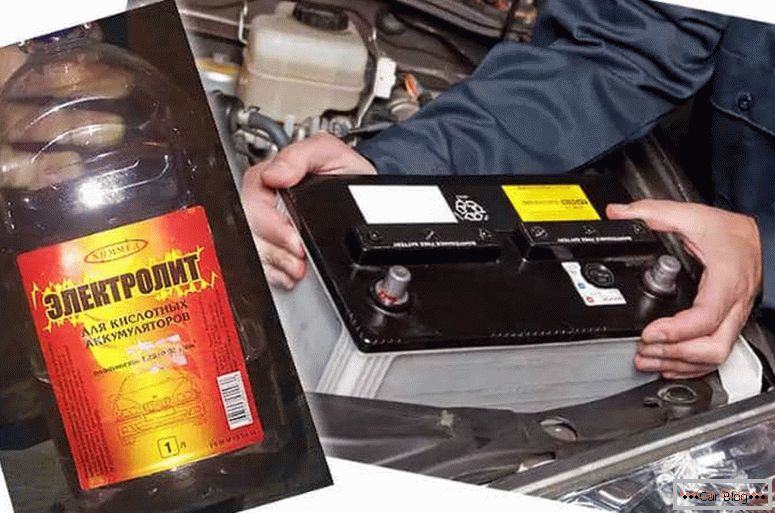
You need to know that the electrolyte in banks should be at a level above the protection of 10-12 mm.
Using a multimeter or another tester, we check the battery charge. If necessary, the battery is charged. Then it is necessary to allow the entire system to cool for 1-2 hours.
Replacement work
Using a rubber bulb or a hydrometer, pump electrolyte into prepared containers. To completely remove electrolyte, some car owners drill small holes in the bottoms of cans, and later they are sealed with acid-resistant plastic. This procedure can be replaced by tilting the battery to the side and pumping out the last drops of a pear from it.
You need to know that when working with electrolyte requires maximum attentiveness and accuracy, since any drops of liquid on the fabric or metal do not appear immediately.
The work uses reliable locks holding the battery on a workbench or desktop in the desired position. It is allowed to wear a thin tube on the free end of the hydrometer to carefully remove the liquid from the can.
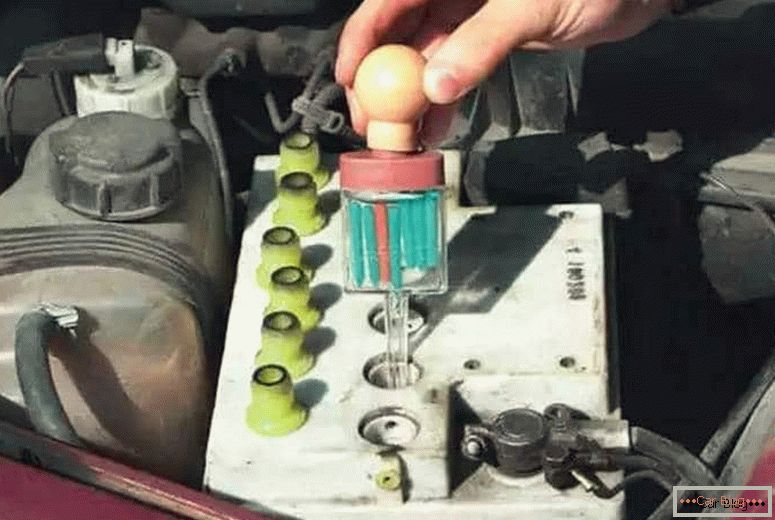
Do not turn the battery upside down to remove fluid!
Possible chemical debris that has accumulated at the bottom of the cans can fall onto lead plates and get stuck between them. This action leads to a short circuit of the banks and the complete failure of the battery.
After complete discharge of fluid from the cavity, return the body to the standard operating position. At this time, it is not necessary to add electrolyte to the battery, as it is necessary to pre-rinse the battery with distilled water. For this we use a funnel and a tank with distillate. Shake and turn the case with water for high-quality washing is not necessary because of the possible presence of slag at the bottom.
Flushing is done with a gentle sway. in different directions of the battery housing. Next, give a little space and repeat a couple of times swaying. Drain the contaminated distillate and repeat 1-2 times the procedure.
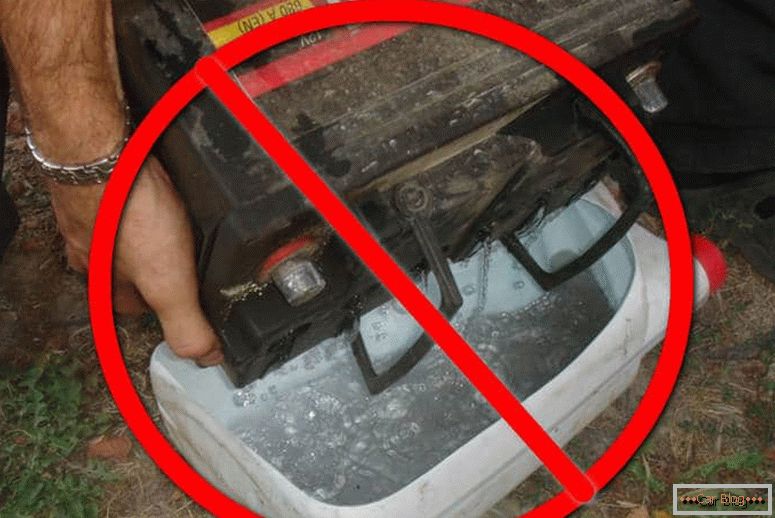
At the next stage, we fill the prepared electrolyte according to the season into the empty cavities. In order to determine how much electrolyte is poured into the battery, we bring the liquid level above protection to 1 cm.
You need to know that in the automotive shops usually sold a denser electrolyte that needs to be diluted with distillate.
Final stage
The filled battery is tilted slightly to the sides so that possible air bubbles rise from the cans. It is necessary to do a few swaying of the battery case. After the procedure, the battery is left alone for 2-2.5 hours. After this time we conduct a visual inspection of the electrolyte level in all banks, if necessary, make topping up.
See also: How to pick up the battery by brand of carThe next step is to recharge the battery with a current of no more than 0.5-0.7 A for 2-3 hours. For quality and long-term work, it is desirable to conduct a control and training cycle with full discharge and then full charging of the battery.

During the discharging procedure, you can throw a 12 V incandescent lamp on the battery’s contacts;
Safe operation with electrolyte
If even a small amount of electrolyte gets on the skin of a person, a chemical burn occurs. This is especially dangerous for the mucous membrane of the eyes. If such an event occurs, the wound is washed immediately with a large amount of running water. You can use a weak soda solution for this. With a large lesion of the skin area, you should immediately consult a doctor.
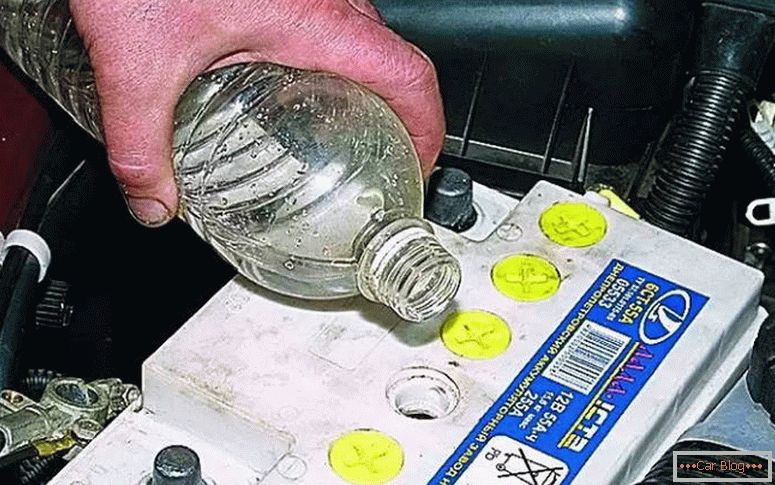
Remaining electrolyte must be disposed of. If it is not possible to do this, then it is enough to drain it into one container and gradually add baking soda to the liquid. During the process, there will be a violent reaction with heat generation and foaming. After completion of all processes, when the solution will not react to the addition of soda, it can be drained into the sewer system.

